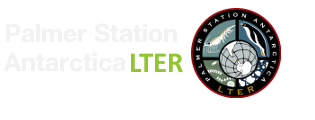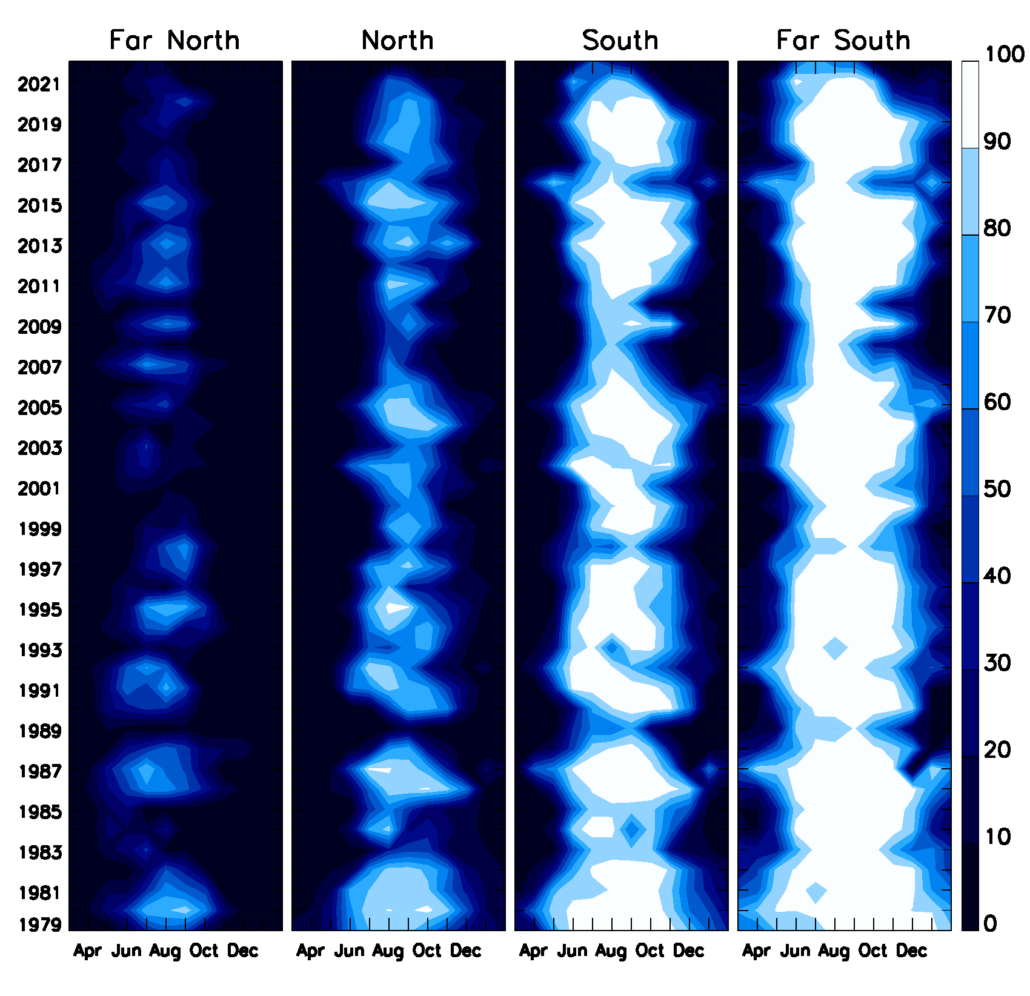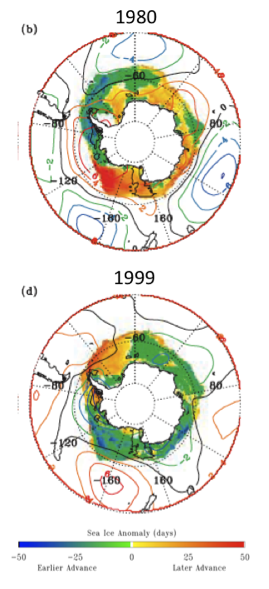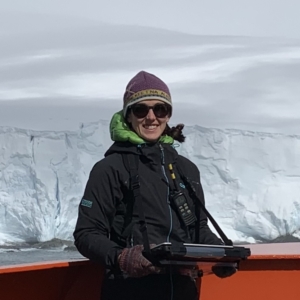Sea Ice and Climate
Group PI: Sharon Stammerjohn
The western Antarctic Peninsula (WAP), inclusive of the PAL LTER study region, is one of the fastest changing regions on earth, with an annual warming 4 times the global rate since the early 1950’s (~0.13 degC/decade globally versus 0.65 degC/decade WAP). The seasonality of sea ice shows similar rapid changes (figure below left): the autumn advance is occurring ~2 months later (over the last 45 years, 1979-2023) and the spring retreat ~1 month earlier, both resulting in a ~3-month shorter annual ice season.
Decadal changes in monthly surface air temperature (figure below right) measured at several WAP stations (north-to-south) reveal pronounced winter warming over the last 3 decades, particularly mid-peninsula in the heart of the PAL study region, concurrent with the disappearance of perennial sea ice (in blue) to the south and shorter ice seasons throughout the PAL study area.
Using satellite and meteorological data of ice-climate variability (which extend our ship-based and near-shore based observations both seasonally and regionally), we investigate and evaluate how seasonality, a dominant phenological control of the marine ecosystem, is changing on space/time scales relevant to the ecology. Our large-scale analysis also indicates that the WAP region is particularly sensitive to El Niño Southern Oscillation (ENSO) and Southern Annular Mode (SAM) variability. For example, during the La Niña and +SAM that occurred in austral spring-autumn of 1998-99 (e.g., autumn in figure left, bottom panel), low atmospheric pressure anomalies west of the Antarctic Peninsula (blue contours) intensified warm northerly winds over the WAP, resulting in wind-driven sea ice decreases (earlier spring retreat and later autumn advance, the latter depicted here). The opposite occurs during El Niño and/or –SAM, e.g., the austral autumn in 1980 (figure right, top panel) when –SAM conditions produced high-pressure anomalies and cold southerly winds over the WAP and an earlier austral autumn sea ice advance. Within this context of climate sensitivity and change, and in conjunction with the other components, we strive to seasonally resolve how surface forcing, sea ice in particular, influences ocean mixed layer processes, and hence the biological and biogeochemical response of the marine ecosystem, through both observations and modeling studies.
Team Members
Selected Publications
- Himmich, K., Vancoppenolle, M., Stammerjohn, S., Bocquet, M., Madec, G., Sallee, J-B., Fleury, S., 2024. Thermodynamics drive changes in the Antarctic sea ice seasonal cycle following 2016, J. Geophys. Res., https://doi.org/10.1029/2024JC021112
- Reid, P., S. Stammerjohn, R. A. Massom, S. Barreira, T. Scambos, & J. L. Lieser, 2024. Sea ice extent, concentration, and seasonality [in “State of the Climate in 2023″]. Bull. Amer. Meteor. Soc., 105 (x), S3xx–S3xx, https://doi.org/10.1175/BAMS-D-24-0099.1
- Saenz, B.T., McKee, D.C., Doney, S.C., Martinson, D.G., & Stammerjohn, S.E. 2023. Influence of seasonally varying sea-ice concentration and subsurface ocean heat on sea-ice thickness and sea-ice seasonality for a ‘warm-shelf’ region in Antarctica., Journal of Glaciology, 69(277), 1466-1482, https://doi.org/10.1017/jog.2023.36
- Xin, M., Clem, K. R., Turner, J., Stammerjohn, S. E., Zhu, J., Cai, W., & Li, X. 2023. West-warming east-cooling trend over Antarctica reversed since early 21st century driven by large-scale circulation variation, Environmental Research Letters, 18, https://doi.org/10.1088/1748-9326/acd8d4
- Meredith, M. P., Stammerjohn, S. E., Ducklow, H. W., Leng, M. J., Arrrowsmith, C., Brearley, A. J., Venabkes, H. J, Barnham, M., Melchiorr, Wessem, J., Schofield, O., Waite, N. 2021. Local- and large-scale drivers of variability in the coastal freshwater budget of the Western Antarctic Peninsula. J. Geophys. Res.. DOI: 10.1029/2021JC017172
- Stammerjohn, S. E., and Scambos, T. A. 2020. Warming reaches the South Pole. Nat. Clim. Chang. (2020). https://doi.org/10.1038/s41558-020-0827-8
- Stammerjohn, S., and Maksym, T. 2017. Gaining (and losing) Antarctic sea ice: Variability, trends and mechanisms. In D. Thomas (Ed.), Sea Ice, 3rd Edition. West Sussex: Wiley-Blackwell.









 This site was developed with the support of the National Science Foundation under Grant No. OPP-2224611 and OPP-2026045. Any opinions, findings, and conclusions or recommendations expressed in this material are those of the authors and do not necessarily reflect the views of the National Science Foundation.
This site was developed with the support of the National Science Foundation under Grant No. OPP-2224611 and OPP-2026045. Any opinions, findings, and conclusions or recommendations expressed in this material are those of the authors and do not necessarily reflect the views of the National Science Foundation.